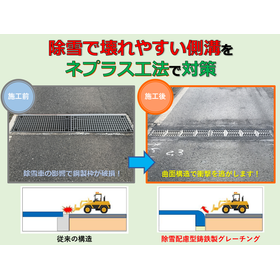NK Rust Stabilization Anti-Corrosion Method for Repainting Lead-Containing Paints - NETIS Registered
Repainting lead-containing paint reduces costs with the NK rust stabilization anti-corrosion method.
Work such as stripping lead-containing paint must be conducted in accordance with regulations for the prevention of lead poisoning, requiring wet methods. However, lead-containing anti-rust paints like red lead cannot be removed by stripping, so a combination of two types of surface preparation is used. The NK rust stabilization anti-corrosion method can be applied while leaving an active film, which helps reduce surface preparation costs and safety measures. The paint system is made from safe materials that do not contain harmful heavy metals.
Inquire About This Product
basic information
Work process for repainting lead-containing paint using the NK rust stabilization anti-rust method 1. Application of stripping agent 2. Scraping off 3. Two types of surface preparation only on exposed steel parts 4. Degreasing and cleaning with alcohol 5. Application of NK-100E (first coat) 6. Application of NK-100E (second coat) 7. Intermediate coating with Seal Coat 007M 8. Top coating with Seal Coat 007M NK-100E: Solvent-free epoxy resin-based rust stabilization paint Seal Coat 007M: Inorganic paint
Price range
Delivery Time
Applications/Examples of results
Painting and maintenance repairs of steel structures such as bridge repairs.
catalog(1)
Download All CatalogsCompany information
The NK rust stabilization anti-corrosion method involves three types of surface preparation, with a primer using a solvent-free epoxy resin-based rust stabilization paint, and an intermediate and top coat using inorganic paint. The primer, NK-100E, is solvent-free and has strong adhesion and high gas barrier properties, making it a safe paint that does not compromise the active film. The film wear rate of the intermediate and top coat, Seal Coat 007M, is slower than that of fluorine, ensuring a film thickness that is twice as thick. T&C Anti-Corrosion for salt damage is a combined type of impregnation material that combines silicate-based impregnants and silicone-based water repellents. It is a hybrid type that possesses the advantages of both types of impregnants, effectively preventing the intrusion of carbon dioxide and water, making it particularly effective in salt damage environments. In general environments, T&C Anti-Corrosion is utilized. Nano Coat Clear is a breathable glass paint suitable for protecting exposed concrete, preserving the texture of the exposed concrete. The method using inorganic paint achieves long-term durability for structures such as social infrastructure and contributes to the reduction of life cycle costs (LLC).










